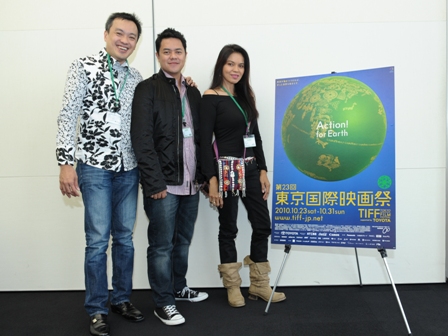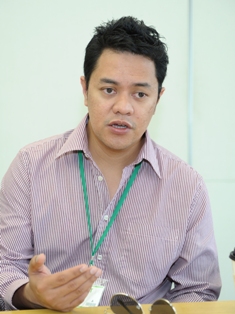2010.10.29
[Interviews]
Winds of Asia-Middle East ŌĆ£Ways of the SeaŌĆØ Interview with Sheron Dayoc (Director), Lilit Reyes (Producer), Maria Isabel Lopez (Actress) (10/29)


©2010 TIFF
---Did you make this film because of the illegal immigration in your hometown?
Sheron Dayoc (Dayoc): Yes. My hometown is where stowaways set sail from and deportees from Malaysia return to. The number of deportees increased from about 2002 when the government started to tighten the controls. The death rate went up at the same time due to lack of air or food as they are so tightly packed on the ship. I learned a lot from lawyers who are dealing with such cases. This film is based on real cases.

©2010 TIFF
---You have made documentaries before this film, but why did you make this a narrative film?
Dayoc:I was going to make a documentary, but I would have needed to board the same vessel as the stowaways, and cross the boarder to Malaysia. It is too much of a risk and almost impossible, that is why I made it into a narrative film. But I believe the audience can sense the same message as a documentary.
---As a producer, how did you proceed with the production?
Lilit Reyes (Reyes): We secured the funding of 1 million yen from Cinemalaya film festival (gateway for young film directors), but that is not enough to complete a film. The fund ran out half way through the production, yet the film sincerely portrays PhilippinesŌĆÖ compelling issue and I really wanted to complete it. I relied on some of my friends in an advertisement company, who provided some of the sound and music for free.

©2010 TIFF
---Maria, you are a top actress in the Philippines. What encouraged you to perform in this film?
Maria Isabel Lopez (Lopez): I did not know SheronŌĆÖs name, but I found out he was a promising director, young but not cocky. I read the script and I realised that it is an important film, which should be known by many people.

©2010 TIFF
---I would think many illegal immigrants will just clam up. The research must have been difficult.
Dayoc:I heard a lot of stories from people who have been deported back here. There is a place where these people are temporarily housed. There were some who just didnŌĆÖt want to talk to us, but the communication improved after we started to provide a questionnaire via the social worker. Some were really keen to tell us what hardships they had endured. All the stories have been incorporated in the script and the end result is {Ways of the Sea}.
---ItŌĆÖs a sensitive issue in the Philippines. Were you criticized or bashed?
Dayoc:Not all the stowaways are from Zanboanga, and many are from other regions. But when they are sent back here, the local authority must bear the cost of housing and feeding them as well as providing some transportation subsidy. So the mayor of Zanboanga did not approve of accepting illegal immigrants for economic reasons. He wanted as many people as possible to know about the problem so he was very cooperative.
---Many scenes are filmed on the sea at night. Shooting must have been difficult.
Dayoc: When we filmed on the ship, the only light sources were lamps, and it lasted only for a few hours. I had to shoot everything within 4 hours, so it was difficult.
Lopez:When we filmed in the mangrove forest, it was like a swamp on the ground. SomeoneŌĆÖs boots got stuck in the mud, a boot fell off his foot, and he got bitten by a sea serpent. Rescue crew was with us but still, it was very scary.

©2010 TIFF
---YouŌĆÖve completed it, despite many difficulties, and it must have been worth it.
Dayoc: Both cast and crew worked really hard and enthusiastically, I feel lucky to have been supported by them. Budget was limited, location was difficult, but every one said at the end that they really enjoyed it. It was a big challenge, but I had a wonderful experience.
---How do you feel about its screening at the TIFF?
Dayoc:The issue is why do the Philippines take such an enormous risk to stay as illegal immigrants without any prospect for the future? We need to think about this. We went to Pusan, too. It is truly meaningful to have this screened in every country in Asia. The screening in Tokyo has been a wonderful experience.
(Interviewed by Gen Suzuki)
Ways of the Sea
Film Information




